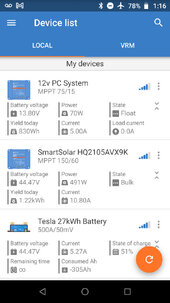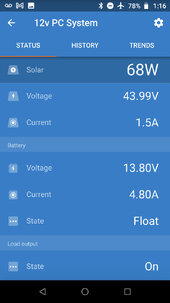Pi Curio
Sunlicious
I've spent quite a bit of time going through hundred of solar panel datasheets to find a good panel match for this SCC that would enable me to fully utilize this small SCC beast.
Two panels are a darn near perfect match for this SCC, depending on what you have to work with space-wise, temperatures, etc.
So without further ado, here's what I've found to be a good match for this SCC.
A more elegant combo is 100/20 with 3x Sunpower Maxeon3 400w panels in parallel for a total of 1200W
Voc 75.6V & Isc 6.58A per panel.
A more flexible combo, 100/20 with 12x Ecoflow Rigid 100W solar panels in 4S3P configuration
Voc 20,3V & Isc 6.3A per panel.
Ecoflow 100W rigid panel
- almost universally available across the globe
- reasonable price, ability to order online with free shipping mostly
- well protected in the box
- each set of two has a sticker on the box with two SN for each panel so you can activate warranty on their official website.
- since it's a part of the whole line of products it's intended for, there's a certain guarantee you'll be able to add more of the same panels going forward with no concerns will it be available in a few years as with some or most of the other panels. So you don't have to buy 12x panels from the get-go, you can do so in steps.
Anyhow, hope it helps shed light on what panel might be worth considering if you're looking to get the most out of Victron 100/20.
Two panels are a darn near perfect match for this SCC, depending on what you have to work with space-wise, temperatures, etc.
So without further ado, here's what I've found to be a good match for this SCC.
A more elegant combo is 100/20 with 3x Sunpower Maxeon3 400w panels in parallel for a total of 1200W
Voc 75.6V & Isc 6.58A per panel.
A more flexible combo, 100/20 with 12x Ecoflow Rigid 100W solar panels in 4S3P configuration
Voc 20,3V & Isc 6.3A per panel.
Ecoflow 100W rigid panel
- almost universally available across the globe
- reasonable price, ability to order online with free shipping mostly
- well protected in the box
- each set of two has a sticker on the box with two SN for each panel so you can activate warranty on their official website.
- since it's a part of the whole line of products it's intended for, there's a certain guarantee you'll be able to add more of the same panels going forward with no concerns will it be available in a few years as with some or most of the other panels. So you don't have to buy 12x panels from the get-go, you can do so in steps.
Anyhow, hope it helps shed light on what panel might be worth considering if you're looking to get the most out of Victron 100/20.
Last edited:




